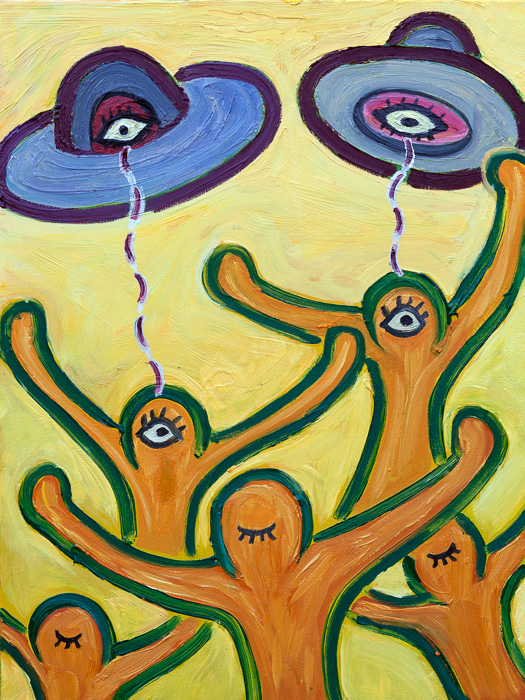Lately I’ve been writing some “How to Write” posts for my blog and for Medium. For this one, I’m using excerpts from my huge document All the Interviews, which you can read as a PDF online. Today’s topic is “Getting Ideas.” And I have a Part II on my blog and on Medium as well.

From an interview by Nozomi Ohmori. Tokyo, 1990, for Hayakawa SF Magazine
There is a strong relationship between my nonfiction and novels. For instance, White Light can be considered as a sort of novelization of Infinity and the Mind. And Infinity and the Mind also includes the Software idea about self-reproducing robots evolving to become intelligent; this is in a section called “Towards Robot Consciousness.”
The ideas in The Fourth Dimension appear in The Sex Sphere and again in Realware, which has a number of scenes in the fourth dimension. The Hacker and the Ants can be thought of the fiction version of the research I carried out to write my software package Artificial Life Lab.
My fantastic fake-nonfiction novel, Saucer Wisdom, introduced the science ideas used in Freeware and Realware. The ideas include the Freeware “uvvy” communication device, the Realware “alla” matter controller, and the aliens who travel as radio waves. It’s like now I’m reaching a point where even my nonfiction is speculative.
I used to like to say that SF is my laboratory for conducting thought-experiments. But maybe when I said that I was just trying to impress my academic friends. Now that I’m older, I’m more likely to tell the truth. I don’t write SF to help my science. If anything, I study science to help my SF! I love SF for the ideas, but more purely I love it simply for the rock’n’roll feel of it, the power-chords, the crunch, funk.
Now I’ve been teaching software engineering in Silicon Valley. At the low level, teaching programming is like teaching automobile repair — just having to explain these random arbitrary things like the part-numbers of the pieces inside some particular model vehicle’s carburetor. And you can’t just skip over that stuff because the whole point of programming is to get a nice program that works really well on some specific actual machine.
At a higher level, I’ve learned a lot about computer stuff like fractals, chaos, cellular automata, complexity, Virtual Reality, and Artificial Life, so it would seem like a good idea to write a book about that. But these topics are very picked over; too many people have written about them. It’s like looking for a cigarette butt on the West Point parade ground. Even so, in 1997 I was trying hard to get a contract to write a nonfiction book like this. I wanted to tie the computer-inspired ideas more closely to immediate perceptions of Nature and to one’s own mental experiences. But somehow ended up with a contract to write Saucer Wisdom, a book about my fictional encounters with a man who’d been shown the future by some saucer aliens! It’s not always easy to predict what book you end up writing. Certainly my work with computers has very much affected the way I see the world, and maybe someday I can figure out a marketable way to write about this.

From an interview by Michiharu Sakurai. Tokyo, 1997, for [relax]
Transrealism means writing about your immediate perceptions in a fantastic way. The characters in a transreal book should be based on actual people. This has the effect of making the characters be richer and more interesting. One inspiration for me in doing this is Jack Kerouac, who thought of his novels as a single linked chronicle. Though many would just call Kerouac’s books autobiographical novels.
My transreal novels aren’t exactly autobiographical: I have never really left my body, climbed an infinite mountain, met a sphere from the fourth dimension, infected television with an intelligent virus, etc. But they are autobiographical in that many of the characters are modeled on family and friends — the main person of course being modeled on me. The science fictional ideas in my transreal fiction have a special role. They stand in for essential psychic events.
The quest for infinity, for instance, is nothing other than the soul’s quest for God. Or, more mundanely, it represents the individual’s quest for meaning. In another sense, a White Light at the top of a transfinite mountain stands for the psychedelic experience, which loomed large in those years when White Light was written (1978 – 1979). But, again, the whole point of the psychedelic experience, at least from my standpoint, was to see God. Another inspiration for me in pursuing transrealism is Philip K. Dick. His blackly hilarious book A Scanner Darkly was a real inspiration for me in forming my ideas about this way of writing. And in fact Scanner had a blurb on it describing the book as “transcendental biography,” which was probably the reason I coined the word “transreal.”
In a nutshell, transrealism means writing about reality in an honest and objective way, while using the tools of science fiction to stand for deep psychic constructs.

From an interview by Tatiana Shubin un San Jose, 2003, for Math Horizons.
You asked about math and SF. One thing we do in mathematics is to investigate the consequences of constraints or assumptions. You might, for instance, add a new axiom of set theory and then see if any nice theorems come out of this. Or you might make a definition, such as “an Archimedean solid has regular polygons for its faces (not necessarily all the same) and has the same arrangement of polygons meeting at each vertex,” and then carry out a search, partly empirical and partly theoretical, to characterize the objects satisfying your definition.
Science-fiction can be carried out in this vein. Thus I might ask what would happen if people had “femtotechnolgy” wands that would turn dirt or air into whatever kinds of objects they wanted. Or what would happen if people could make hundreds of copies of themselves. Or what it would be like if we had a mountain as tall as all the transfinite ordinals.
Science fiction can be thought of as a laboratory for carrying out thought experiments. The bare idea of a femtotechnolgy wand doesn’t tell you much. You need to do some work to investigate the consequences. In effect, you have to carry out a simulation of a society with your additional assumption. This is in some ways similar to what we do in mathematics.
Note that just thinking about a question often isn’t enough. You need to write something down. The paper does part of the work, that is, the act of writing elicits further ideas and fills in details, regardless of whether you’re writing literature or math.
Something I learned from mathematics was to never turn back from an idea just because it seems too counterintuitive. Logic can take you to some very strange places.
All this said, I need to point out that science-fiction is also quite different from mathematics. SF is a form of literature, after all, and literature involves creating realistic human characters and using words to capture one’s sensations and emotions. Personal human experience isn’t something that mathematics directly deals with.

From an interview by Lori White in Oakland, 2005, for Strange Horizons
You asked me about Edwin Abbott’s book Flatland. When I was in high-school, perhaps the tenth grade, my best friend and next-door neighbor Niles Schoening told me about this odd book he’d found in the Louisville Public Library. About characters who were squares and triangles and lines. I was intrigued, and I read the book.
On the first reading, the book confused me. Even though I’d read some Golden Age science fiction stories about the fourth dimension, I didn’t I initially understand that Flatland contains a series of analogies intended to help us visualize the fourth dimension. At the time I wasn’t yet aware that the fourth dimension is something solid and precise that it’s possible to actually understand. And, on a first reading, the satirical aspects of Flatland threw me off as well. The hero A Square is kind of a Victorian Everyman, not all that bright, and full of dumb received ideas about social class.
When my parents took me to begin Swarthmore College in the fall of 1963, my father bought me a paperback edition of Flatland in the little town drugstore. He himself was interested in the book; he’d recently become ordained as an Episcopal priest, and he saw the main character A Square’s experiences in the third dimension as an analogy to the spiritual life. I dipped into the book several times in the coming four years, but still didn’t get very passionate about it. I was too busy being a college student.
My interest finally came to a boil in 1970. I was at Rutgers University working on my doctorate in mathematics, and all sorts of things about mathematics were becoming clear to me, ranging all the way from the meaning of infinity and logical proof down to how carrying and borrowing work in pencil-and-paper arithmetic. Finally I began to understand what Flatland was getting at.
I was also getting interested in relativity theory, and one problem that nagged at me was how the geometric fourth dimension suggested by Flatland relates to the fourth dimension as used in relativity theory to represent the axis of time.
I was married by then, and we’d had our first child Georgia, and there was this one weekend when my wife had taken the baby to go visit her parents at the Watergate hotel in D. C. I was listening to a great new vinyl Frank Zappa album, Chunga’s Revenge, smoking pot, and thinking about the fourth dimension. I was also into underground cartooning then, I was drawing a strip called Wheelie Willie for the Rutgers Daily Targum. On this one magical evening alone with my speakers propped up the desk playing “The Nancy and Mary Music,” I started making Rapidograph drawings of A Square and of the spacetime diagrams of relativity theory, working them into an explanatory narrative, with captions and little bits of connective text. One of the nice things about the Flatland characters is that they’re very easy to draw!
A few weeks later my father was visiting our apartment and I showed my work to him — I had maybe a dozen pages done by now — and he was interested but a little baffled that I’d become that interested in the ideas of Flatland. “Where are you going with this?” Where I was going was into my career as a science and science fiction writer. But I didn’t know this at the time.
My friends in grad-school even began teasing me about my interest in Flatland a little bit. I was carrying around Dionys Burger’s Flatlandesque book Sphereland, and an English major friend asked me, “So is your career goal to write, like, Tubeland?”

My first teaching job was at what’s now called SUNY Geneseo in upstate New York and I took over a course called Foundations of Geometry. I was supposed to be focusing on axiomatic approaches to geometry, and I covered Euclid, but most of my course was focused on the fourth dimension. I wrote up some lecture notes that I mimeographed for the students; the notes were initially called Geometry and Reality and they grew into my first book, Geometry, Relativity and the Fourth Dimension (Dover Publications, New York 1977).
In my first book I invented some further adventures for A Square. And my 1983 story collection The Fifty-Seventh Franz Kafka included several science-fiction stories involving the fourth dimension, including “Message Found In A Copy of Flatland,” and “The Indian Rope Trick Explained,” both of which include drawings of good old A Square.
I also took another crack at a nonfiction book about fourth dimension: The Fourth Dimension (Houghton Mifflin, Boston 1984.) In the course of this book I describe events in an imaginary book called The Further Adventures of A Square. I tell about A Square having affair with the Flatlander A Hexagon’s wife Una — I really enjoyed copying the style of Flatland — which was already archaic at the time that Abbott wrote the book, remember that he was, among other things, a Shakespearean scholar.
At the very end of writing my Fourth Dimension book, I hadn’t tied up one last loose end, I’d left A Square cornered by an angry A Hexagon. And I had a dream of A Square down in Flatland, chirping up at me for help. So that went into my book too, at the very end, another excerpt from The Further Adventures of A Square. Here’s a quote from The Fourth Dimension (pp. 202-203).
I felt myself as but a Thought, a baseless fragment of some recurrent Dream. All around me I sensed my Dreamer’s mind. Mustering my courage, I cried out my plaint.
I: Can you hear me, my Lord?
Dreamer: And how! What time is it?
I: There is no Time — so says the Sphere.
Dreamer: Well, yeah. Not for you, anyway.
I: Return me to my fellows, oh my Author. Grant that the Hexagon forgives me.
Dreamer: I can do that. And thanks, I’ve enjoyed being with you. I hate to say good-bye.
I: But surely you will always be with me? Is not my World a fragment of your Mind?
Dreamer: It’s not my mind, really. I’m just filling in. Who knows who’ll dream you next. You’re the real immortal, Square, not me. You’re an eternal Form.
For an instant I could see it All: the boundless Truth, the many Dreamers, and my own life’s passionate play.
I was actually crying when I wrote this.
What I was getting at is that when you write about a shared world, like Flatland, or the Star Wars universe, or for that matter human history, you’re describing characters who in transcend any individual author. And that’s kind of awesome.

From an interview by Carmine Treanni. in Rome, 2005, for Quaderni D’Altra Tempi
When I start, I always have in mind a few crucial situations or devices that I’m eager to explore and depict. These ideas arise to some extent spontaneously, and to some extent from thinking about scientific and social ideas that interest me.
Once I have a vague idea of the book’s theme, I begin working on figuring out the characters, the geography, the society, the tone, the point of view, the story arc, the physics, and, above all, the plot outline.
I write about all these ideas in a notes document that I develop in concert with my novel; usually my notes documents end up nearly as long as my books. I post each of the notes documents online when the corresponding book is published.
The virtue of having a notes document is that then there’s something I can work on when I don’t quite feel ready to write the novel.
When a book’s going well, I can average about a thousand words a day. When I get my thousand words, I print it and go to the coffee shop and reread it and mark it up, then type it in again and repeat the process. I might cycle through a given section three times in a day, and the next day maybe one more time and then I move into the next section.
I tend to be somewhat anxious when I work, worrying I won’t be able to get things to come out right. In general, I worry too much.

From an interview by Ernest Lilley, Brandywine, Maryland, 2006, for SFRevu
I’m so sick of quantum mechanics getting a free ride. It’s an intellectually empty edifice, a false front with nothing behind it. They used to be able to get away with saying, “ah, reality is stranger than we can know,” but I think a lot of us have had it with that line of mystery mongering. Our brains are made of the same quantum mechanical matter as everything else in the world, so if there’s an explanation to be had, there’s no reason we can’t understand it. The foundations of quantum mechanics suffer from a complete and utter bankruptcy of new ideas.
According to a newer new line of thought — I’m thinking of people like Stephen Wolfram, Lee Smolin, and John Cramer — there could well be a deterministic subdimensional physics below quantum mechanics. Quantum mechanics is like mist over the landscape of the crisp underlying reality.
You mention predestination, which is a way of broaching the question, “If the future is determined, does that mean I don’t have free will?” Maybe we don’t have free will, but in practice this isn’t so bad because, at least in the world we live in, the future is computationally unpredictable. Turns out there’s a distinction we didn’t use to be aware of. The future can pre-exist in an idealized kind of way, but it may well be that it is even in principle impossible to predict it. This is widely believed to be the case in our world.
In Mathematicians in Love, they start out in a world in which the world’s computation is in fact simple enough that they can make a device to predict the future, but they end up in our rich and gnarly world, where prediction is a practical impossibility. I also discuss these ideas in my nonfiction book, The Lifebox, the Seashell and the Soul.

From an interview by R. U. Sirius, in San Francisco, 2007, for MondoGlobo
A lot of the ideas in my recent novels come from Stephen Wolfram’s work. My The Lifebox, the Seashell, and the Soul was largely about his work. The basic idea is that any natural process can be regarded as a computation. We define computation in a fairly broad sense to mean any deterministic system that obeys definite laws. And it doesn’t have to be digital.
The digital thing is sort of a red herring. We have this idea that being a computer is about being digital. But computers aren’t actually digital, OK? They’re made of a bunch of electrons. And the electrons are fuzzy analog wave functions.
So you can look at a brook or an air current and you can say, “That’s doing something complex.” And if you look at the natural world, there are four kinds of things that you see. Where something is sort of stable — not changing — it’s static. Or else it’s doing something periodic. Or it’s completely fuzzy and like totally scuzzy and screwed up. Or it’s in the interface zone — which is what I call the gnarly zone — the zone between being periodic and being completely scuzzy.
Life is gnarly. Plants are gnarly. Air currents are gnarly. Water currents are gnarly. Fire is gnarly. In Wolfram’s view, every one of these actually embodies a universal computation, similar to a universal Turing Machine or a personal computer, and in principle they can compute anything that you want it to. I agree with him.
Wolfram says interesting things about evolution. He does talk about evolution a little bit. Someone might say, “How could a butterfly have evolved that precise pattern on its wings? Or how could we evolve the exact shape of our body.” And Wolfram makes the point that natural systems are actually fairly robust computations. They like to do things like make spots on butterfly wings or grow limbs from animals. The genetic code doesn’t have to be as finely tweaked as people sometimes imagine. You could actually perturb it quite a bit and you would still get plants and animals that look pretty similar to the way we look now. So it’s not so much that things evolve to perfection. They just get to a level of functioning well enough. In fact, we aren’t tuned to complete optimality.

From an interview by Anneli Rufus in Berkeley, 2009, for East Bay Express
The ideas trickle in unpredictably. Often I’ll push for an idea, focusing on a story situation and trying to imagine what comes next. When I’m brainstorming like this, it helps to be taking notes, either on a scrap of paper, or by actually typing into my laptop. Making little drawings helps, too. But I don’t always get the full insight that I need while I’m pushing. The search seems to continue in my subconscious, and maybe a few hours or even days later I’ll get an “aha” moment about what I need to do. That’s what we call the muse.
And I do go out and do research. When I was working on Hylozoic, I made a trip to Hieronymus Bosch’s home town, s’Hertogenbosch in the Netherlands. I used the material from that visit a lot, it was rich. And My wife and I lived for week in a flophouse on Valencia Street in San Francisco, and I picked up some local color there. And I read this scholarly book by David Skrbina, Panpsychism in the West, about the history of the idea that objects might be able to think. And always I’m cruising the web, watching movies, reading…looking for clues everywhere.

From an interview by Mike Perschon, in Edmonton, Canada, 2009, for Steam Punk Scholar
I think there’s still a lot of room of all kinds inside science fiction. My genre’s house has many mansions.
The field isn’t very old when you think about it—I’m only like the second generation of science fiction writers, next in line after Fred Pohl. But already you have to be careful not to repeat the old things. I don’t want it to be like I’m throwing down standardized cards that say, like, time machine, spaceship, robot. And I don’t want to write SF that’s parodistically or self-mocking. If the ideas become juiceless tropes, that’s not interesting. As an extreme of this, in certain comedic SF books I feel like the authors are saying “Oh let’s just be silly—SF is all silly garbage, let’s be silly together.” It degenerates into fan fiction where, again, you’re just throwing down picture cards and laughing at them. That’s not a route I want to take.
It’s all about making up new tropes, or using the old ones in fresh ways. There’s always more cool new stuff we can work with, and the future is coming faster than people can absorb. We don’t want to fall back on recycling whatever Heinlein and Asimov did, any more than a contemporary musician wants to emulate Sinatra or even the Beatles. That’s over, it doesn’t speak to our time.
I’m particularly leery of using things that I see on TV or in the movies…that crap is so watered down, it’s written by fifteen people, it’s completely under the establishment’s control. Star Trek is another way for the government to grind its boot into your face, another way for the rulers to indoctrinate the masses with lies about society.
I like to think of science fiction as an edgy literature, like the beatniks or the punks, where we’re turning our backs on the bullshit, we’re trying to make a new world, we’re trying to look at things with fresh eyes. And it’s always possible to look at things with fresh eyes. It’s never been easy to do that, but it’s not any harder now than it ever was.
I think it’s exciting when you have science fiction where you don’t depend on your characters working in a government lab. If you just need to have an arbitrary door to another world, then let’s do it. I mean, there’s been so many surprises in the history of science, why would we think we couldn’t still have something really surprising happen?
And if it’s mysticism—fine. We really have no idea what’s really going on.








